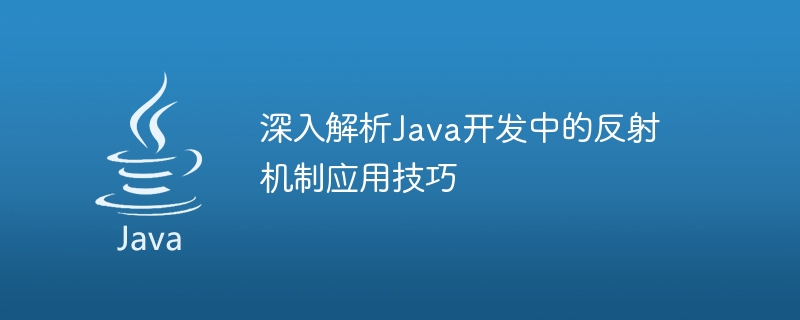

In-depth analysis of the reflection mechanism application skills in Java development
Introduction:
In Java development, the reflection mechanism is a powerful and widely used technology . It allows the program to inspect and operate information on classes, interfaces, member variables, methods, etc. at runtime. The reflection mechanism plays an important role in many scenarios, such as dynamic proxy, annotation processing, framework development, etc. This article will provide an in-depth analysis of the reflection mechanism application techniques in Java development to help readers better master and utilize this technology.
1. The principles and basic concepts of the reflection mechanism
The reflection mechanism is the basis for realizing dynamics in the Java programming language. It implements dynamic operations on classes by analyzing the structure and behavior of classes and objects at runtime. In the reflection mechanism, it mainly involves the following core classes and interfaces:
2. Application skills
Taking dynamic proxy as an example, assuming we have an interface Calculator, we want to print the log before calculating each method. We can use dynamic proxy to achieve:
public class CalculatorProxy implements InvocationHandler {
private Object target;
public CalculatorProxy(Object target) {
this.target = target;
}
public Object invoke(Object proxy, Method method, Object[] args)
throws Throwable {
System.out.println("Before method " + method.getName() + " is called...");
Object result = method.invoke(target, args);
System.out.println("After method " + method.getName() + " is called...");
return result;
}
}
public class Main {
public static void main(String[] args) {
Calculator calculator = new CalculatorImpl();
CalculatorProxy calculatorProxy = new CalculatorProxy(calculator);
Calculator proxy = (Calculator) Proxy.newProxyInstance(
calculator.getClass().getClassLoader(),
calculator.getClass().getInterfaces(),
calculatorProxy);
proxy.add(1, 2);
}
}Through dynamic proxy, we can print logs before and after executing add() method. In this way, we can enhance the method through a proxy class.
For example, we can define a custom annotation MyAnnotation and add it on the method:
@Retention(RetentionPolicy.RUNTIME)
@Target(ElementType.METHOD)
public @interface MyAnnotation {
String value();
}
public class MyClass {
@MyAnnotation("Hello, World!")
public void myMethod() {
// method implementation
}
}Then, use reflection to read and parse Annotations:
public class AnnotationProcessor {
public static void main(String[] args) throws NoSuchMethodException {
MyClass myClass = new MyClass();
Method method = myClass.getClass().getMethod("myMethod");
if (method.isAnnotationPresent(MyAnnotation.class)) {
MyAnnotation annotation = method.getAnnotation(MyAnnotation.class);
System.out.println(annotation.value());
}
}
}Through the above code, we can dynamically obtain and parse the annotations on the method.
Take the Spring framework as an example, which can use reflection to implement dependency injection. Spring dynamically creates instances by scanning class annotations and injects instance dependencies into corresponding member variables.
@Component
public class MyService {
@Autowired
private MyRepository myRepository;
// other methods
}
@Component
public class MyRepository {
// implementation
}
public class Main {
public static void main(String[] args) {
ApplicationContext context = new AnnotationConfigApplicationContext(Config.class);
MyService myService = context.getBean(MyService.class);
// use myService
}
}Through reflection, the Spring framework can dynamically create and inject MyRepository objects into the MyService class.
Summary:
This article provides an in-depth analysis of the reflection mechanism application skills in Java development. Through practical examples such as dynamic proxies, annotation processing, and framework development, readers can better understand and apply reflection mechanisms. Although the reflection mechanism is powerful, it needs to be used with caution. Using reflection at runtime can lead to problems such as performance degradation and code readability. Therefore, you need to weigh the pros and cons and make appropriate optimizations when using the reflection mechanism.
The above is the detailed content of In-depth analysis of reflection mechanism application skills in Java development. For more information, please follow other related articles on the PHP Chinese website!
 What are the calling methods of java reflection
What are the calling methods of java reflection
 createprocess failure reason
createprocess failure reason
 How to activate win7 professional version system
How to activate win7 professional version system
 What do computer software systems include?
What do computer software systems include?
 How to refund Douyin recharged Doucoin
How to refund Douyin recharged Doucoin
 What does data encryption storage include?
What does data encryption storage include?
 The difference between git and svn
The difference between git and svn
 How to distinguish whether two addresses are on the same site?
How to distinguish whether two addresses are on the same site?




